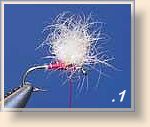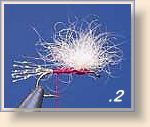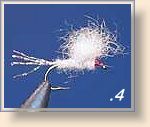The Sparkle-Assed Usual
By Sheldon Seale
Canada is blessed with an abundance of varying hares (aka. snowshoe rabbits). It
is my contention that rabbit, the snowshoe rabbit in particular, is one of the most
versatile sources of tying materials there is. Look at the list of applications. As
a general purpose dubbing, rabbit underfur is excellent. It readily accepts dyes,
making it available in an extensive array of colours. Then there's hare's ear dubbing,
also available in a wide range of colours. We shouldn't forget rabbit strips (cross-cut
or straight) sliced from the cured skin. They make wonderful Strip Leeches (a Matuka
style fly) or the ubiquitous Bunny Fly (which is made solely from cross-cut strips).
Indeed, many patterns call for rabbit strips or can successfully incorporate them.
For example, the Rabbit Strip Matuka Muddler is an excellent, all-round streamer.
Recently, a number of my fishing buddies have been having a great deal of success
with a variation of the Usual (or Philips' Usual, as it was once known). (See the
Summer 1999 issue of The Canadian Fly Fisher for detailed instruction on tying
the basic usual and it's variations.) The Sparkle-Assed Usual (with apologies to
our more sensitive readers, but I didn't name it!) is just one more of those variations
and, recently, it has been proving itself where it counts most - on the water. One of
the most important components of the Usual is, you guessed it, rabbit - in this case,
the hair from the bottom of a snowshoe rabbit foot, which is used for the wing.
The Sparkle-Assed Usual is a simple fly to tie. As you may have noticed from past
articles, I like simple flies. They're fast to tie and they can be very successful, mostly
because you're not afraid to try a cast into a difficult lie since the fly represents a
reasonably small investment in time and materials. They float well, thanks to the
crinkled foot hair that repels water and they are much more durable than flies made
with cul - de -canard.
Recipe - Sparkle-Assed Usual
Hook: standard dry fly hook, sizes 8-16.
Thread: to match body or red, 6/0.
Wing: Snowshoe rabbit foot hair, natural or dyed, Haystack style.
Tail: 4-10 strands of Krystal Flash or similar, pearlescent or root beer colour.
Body: dubbing of choice or to match a natural insect.
Tying Instructions

Step 1. Start the thread behind the hook eye and cover about half the
hook shank. Clip a small tuft of hair from the bottom of a snowshoe rabbit foot
and clean out any loose material in the butts. Tie in with the tips pointing
forward over the hook eye. The wing should be just forward of the 1/3 point
of the hook shank, measured back from the hook eye. The wing length should
be less than the length of the hook shank. Secure with several turns of thread
and trim the butts to a taper. Wrap the butts down and advance the thread in
front of the wing. Take several wraps of thread against the base of the wing
to force it upright.

Step 2. Use your fingers to form the wing into a 180 degree arc over the
top of the hook shank when viewed from the front. Some people prefer an arc of
about 120 degrees, but its a matter of personal preference.

Step 3. Wind the thread to a point behind the wing and tie in 4-10 strands
of Krystal Flash or similar material, depending on the size of the hook. Tie down
along the hook shank to a point just before the hook bend. Secure with a couple
of extra wraps of thread. Trim the tail about as long as the hook shank.

Step 4. Apply dubbing to the thread and form a noodle. Wrap the entire
body to just before the hook eye. Form a small neat head of thread, tie off, clip the
thread and apply some lacquer to the head. The fly is complete.

By the way, I will use snowshoe rabbit foot hair anywhere that calls for a short length
of Antron yarn or a tuft of CDC.
Fishing notes
Is this a dry fly or an emerger? Yes. Grease it up, and it's a good dry fly. Let it settle
in the water with its tail down and it's a great emerger, with the Krystal Flash acting
like a trailing nymphal shuck.
Fish the Sparkle-Assed Usual as you would any other dry fly or emerger. A dead drift
is generally effective. In slower water, a very slight hint of movement, suggesting the
adult struggling free of the nymphal shuck, can often trigger a take. However, it must
be very subtle. I try to impart that hint of movement by gently shaking the rod tip back
and forth a couple of times. Too much movement and you may spook the fish. Start
with a leader about the length of your rod, and adjust your tippet weight for the size
of the fly. In slower water, you may need to lengthen your leader.
The Sparkle-Assed Usual continues the good work begun by Fran Betters and Bill Philips.
By varying the wing and body colour, a wide range of mayflies can be imitated. It's easy
to tie, and made with readily available materials. Dead drifted during an emergence,
it often outperforms more imitative patterns. All in all, itís a good pattern to keep
in your fly box throughout the season.
Variations for popular mayflies
Although these patterns are meant to approximate eastern mayflies, they're impressionistic
enough to work for western species. Moreover, it should be relatively easy to vary size
and colour for any species.
VARIATIONS
|
| Wing Colour* |
Body Colour |
Hook Size |
Insect |
| Dun |
red/brown |
12/14 |
Hendrickson |
| Dun |
red/brown |
10/12 |
Isonychia |
| Dun |
olive |
16 |
BWO's or similar |
| Yellow |
tan |
12/14 |
Cahills or similar |
| Olive |
tan |
10 |
Green Drake |
| Natural |
tan |
8/10 |
Hexagenia |
|





